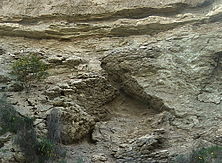
Gypsum
About this schools Wikipedia selection
SOS Children have produced a selection of wikipedia articles for schools since 2005. Click here for more information on SOS Children.
| Gypsum | |
|---|---|
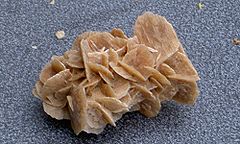 Desert rose, 10 cm long. |
|
| General | |
| Category | Sulfate mineral |
| Formula (repeating unit) |
CaSO4·2H2O |
| Crystal symmetry | Monoclinic 2/m |
| Unit cell | a = 5.679(5) Å, b = 15.202(14) Å, c = 6.522(6) Å; β = 118.43°; Z=4 |
| Identification | |
| Colour | Colorless to white; with impurities may be yellow, tan, blue, pink, brown, reddish brown or gray |
| Crystal habit | Massive, flat. Elongated and generally prismatic crystals |
| Crystal system | Monoclinic 2/m – Prismatic |
| Twinning | Very common on {110} |
| Cleavage | Perfect on {010}, distinct on {100} |
| Fracture | Conchoidal on {100}, splintery parallel to [001] |
| Tenacity | Flexible, inelastic. |
| Mohs scale hardness | 1.5–2 (defining mineral for 2) |
| Luster | Vitreous to silky, pearly, or waxy |
| Streak | White |
| Diaphaneity | Transparent to translucent |
| Specific gravity | 2.31–2.33 |
| Optical properties | Biaxial (+) |
| Refractive index | nα = 1.519–1.521 nβ = 1.522–1.523 nγ = 1.529–1.530 |
| Birefringence | δ = 0.010 |
| Pleochroism | None |
| 2V angle | 58° |
| Fusibility | 5 |
| Solubility | Hot, dilute HCl |
| References | |
| Major varieties | |
| Satin spar | Pearly, fibrous masses |
| Selenite | Transparent and bladed crystals |
| Alabaster | Fine-grained, slightly colored |
Gypsum is a very soft mineral composed of calcium sulfate dihydrate, with the chemical formula CaSO4·2H2O.
Etymology
The word gypsum is derived from the Greek word γύψος gypsos, "chalk" or "plaster". Because the gypsum from the quarries of the Montmartre district of Paris has long furnished burnt gypsum used for various purposes, this material has been called plaster of Paris.
Physical properties
Gypsum is moderately water-soluble (~2.0–2.5 g/L at 25 °C) and, in contrast to most other salts, it exhibits a retrograde solubility, becoming less soluble at higher temperatures. As for anhydrite, its solubility in saline solutions and in brines is also strongly dependent on NaCl concentration.
Gypsum crystals are found to contain anion water and hydrogen bonding.
Crystal varieties
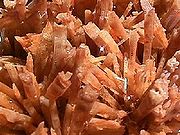
Gypsum occurs in nature as flattened and often twinned crystals and transparent cleavable masses called selenite. It may also occur in a silky, fibrous form, in which case it is commonly called satin spar. Finally it may also be granular or quite compact. In hand-sized samples, it can be anywhere from transparent to opaque. A very fine-grained white or lightly tinted variety of gypsum is called alabaster, and is prized for ornamental work of various sorts. In arid areas, gypsum can occur in a flower-like form typically opaque with embedded sand grains called desert rose. Up to the size of 11 m long, gypsum forms some of the largest crystals found in nature, in the form of selenite.
Occurrence
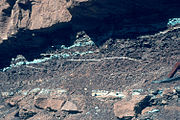
Gypsum is a common mineral, with thick and extensive evaporite beds in association with sedimentary rocks. Deposits are known to occur in strata from as early as the Permian age. Gypsum is deposited in lake and sea water, as well as in hot springs, from volcanic vapors, and sulfate solutions in veins. Hydrothermal anhydrite in veins is commonly hydrated to gypsum by groundwater in near surface exposures. It is often associated with the minerals halite and sulfur.
Because gypsum dissolves over time in water, gypsum is rarely found in the form of sand. However, the unique conditions of the White Sands National Monument in the US state of New Mexico have created a 710 km2 (270 sq mi) expanse of white gypsum sand, enough to supply the construction industry with drywall for 1,000 years. Commercial exploitation of the area, strongly opposed by area residents, was permanently prevented in 1933 when president Herbert Hoover declared the gypsum dunes a protected national monument.
Gypsum is also formed as a by-product of sulfide oxidation, amongst others by pyrite oxidation, when the sulfuric acid generated reacts with calcium carbonate. Its presence indicates oxidizing conditions. Under reducing conditions, the sulfates it contains can be reduced back to sulfide by sulfate reducing bacteria.
Orbital pictures from the Mars Reconnaissance Orbiter (MRO) indicate the existence of gypsum dunes in the northern polar region of Mars.
Mining
Commercial quantities of gypsum are found in the cities of Araripina and Grajaú, Brazil, Pakistan, Jamaica, Iran (world's second largest producer), Thailand, Spain (the main producer in Europe), Germany, Italy, England, Ireland, in British Columbia, Manitoba, Ontario, Nova Scotia and Newfoundland in Canada, and in New York, Michigan, Indiana, Texas (in the Palo Duro Canyon), Iowa, Kansas, Oklahoma, Arizona, New Mexico, Colorado, Utah, Arkansas and Nevada in the United States. There is also a large open pit quarry located at Plaster City, California, in Imperial County, and in East Kutai, Kalimantan. Several small mines also exist in places like Kalannie in Western Australia where gypsum is sold to private buyers for changing the pH levels of soil for agricultural purposes.
Crystals of gypsum up to 11 meters (36 ft) long have been found in the caves of the Naica Mine of Chihuahua, Mexico. The crystals thrived in the cave's extremely rare and stable natural environment. Temperatures stayed at 58 °C (136 °F), and the cave was filled with mineral-rich water that drove the crystals' growth. The largest of those crystals weighs 55 short tons (50,000 kg) and is around 500,000 years old.
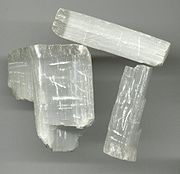
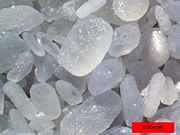
Synthesis
Synthetic gypsum is recovered via flue gas desulfurization at some coal-fired electric power plants. It can be used interchangeably with natural gypsum in some applications.
Gypsum also precipitates onto brackish water membranes, a phenomenon known as mineral salt scaling, such as during brackish water desalination of water with high concentrations of calcium and sulfate. Scaling decreases membrane life and productivity. This is one of the main obstacles in brackish water membrane desalination processes, such as reverse osmosis or nanofiltration. Other forms of scaling such as calcite scaling, depending on the water source, can also be important considerations in distillation as well as in heat exchangers where either the salt solubility or salt concentration can change rapidly.
Uses of gypsum
Gypsum is used in a wide variety of applications:
- Gypsum Board primarily used as a finish for walls and ceilings; known in construction as drywall.
- Plaster ingredient.
- Fertilizer and soil conditioner. In the late 18th and early 19th century, Nova Scotia gypsum, often referred to as plaster, was a highly sought fertilizer for wheat fields in the United States. It is also used in ameliorating sodic soils.
- A binder in fast-dry tennis court clay.
- Plaster of Paris (surgical splints; casting moulds; modeling).
- A wood substitute in the ancient world; for example, when wood became scarce due to deforestation on Bronze Age Crete, gypsum was employed in building construction at locations where wood was previously used.
- A tofu (soy bean curd) coagulant, making it ultimately a major source of dietary calcium, especially in Asian cultures which traditionally use few dairy products.
- Adding hardness to water used for homebrewing.
- A component of Portland cement used to prevent flash setting of concrete.
- Soil/ water potential monitoring (soil moisture tension).
- A common ingredient in making mead.
- In the medieval period it was mixed, by scribes and illuminators, with lead carbonate (powdered white lead) to make gesso which was applied to illuminated letters and gilded with gold in illuminated manuscripts.
- In foot creams, shampoos and many other hair products.
- A medicinal agent in traditional Chinese medicine called Shi Gao.
- A medicinal agent in Ayurveda medicine's Rasashastra branch (Indian alchemy) (ref. Rasamruta).

